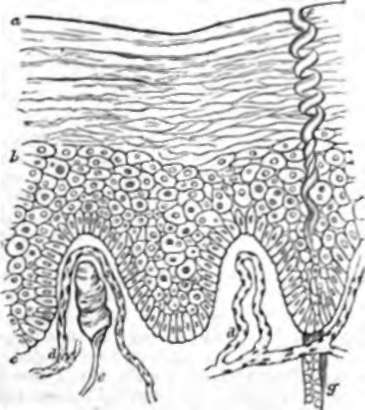41. The Integument
Description
This section is from the book "Animal Physiology: The Structure And Functions Of The Human Body", by John Cleland. Also available from Amazon: Animal Physiology, the Structure and Functions of the Human Body.
41. The Integument
The integument combines the functions of protection, sensation, and secretion, and consists of two parts, the epidermis and the cutis vera.

Fig. 37. Integument or Hand, vertical section magnified, a c, epidermis; a b, horny layer; b c, rate mncosum; c, elongated corpuscles of deepest layer ; d d, capillary blood-vessels in two papillae; e, nerve fibre, ending in a touch corpuscle; f, duct of sweat gland, spiral in the horny layer; g, the same, beneath the integument.
The epidermis, cuticle, or scarf-skin, is a stratified squamous epithelium. When very thin sections vertical to the surface are made through it, and examined under the microscope, it is seen to consist of two parts, which are very different in appearance: a deep part consisting of delicate texture, and a superficial which is horny. The difference may be made very striking by acting on the specimen with a drop of an ammonia solution of carmine, which takes no effect on the horny part, but stains the deep part, and particularly the nuclei, it being the property of that solution so to act on all growing nucleated corpuscles.
The deep part of the cuticle is likewise called the mucous layer (rete mucosum, or Malpighian layer), and it presents several strata of cells. Those which lie deepest, resting on the cutis vera, are always somewhat elongated vertically, while those immediately superficial to these are small, and the remaining strata exhibit cells larger and more flattened the nearer they are to the surface. It appears, therefore, that whatever may be the mode of origin of the deepest or elongated cells, the other layers consist of elements, the history of each of which is, that it has originated as one of the minutest cells, and passes gradually to the surface as it enlarges, undergoing both change of shape and chemical composition, until it becomes incorporated with the horny part of the cuticle, and is ultimately shed from the surface in the shape of a small scale.
The superficial or horny part of the cuticle consists of flattened cells closely adherent one to another, receiving additions from the mucous layer on the deep side, and casting off its oldest cells from the surface in a perpetual insensible desquamation. Its cells may be separated and their nuclei displayed by the action of a solution of caustic potash. The explanation of blistering is, that the mucous layer, acted on by some unwonted irritation, pours out a serous discharge, which, being pent up by the impermeable horny part of the cuticle, separates it from its connections.
The cuticle, besides the mechanical protection which it gives the body, furnishes likewise, by the impermeability of its horny layer, and the intervention of living parts between the surface and the vascular channels within, a protection against the absorption of poisons, so that these, as is familiar to every one, may be handled with impunity when the cuticle is perfect, and yet may be introduced into the system by a very small wound. The surface of the body is not, however, to be supposed incapable altogether of absorbing substances from without. Fluids left in contact with the cuticle, and even solid substances rubbed into it, are gradually absorbed. Probably such absorption takes place principally in the orifices of the sweat glands, but even these are lined with thin prolongations of the horny cuticle, which therefore cannot be regarded as totally impermeable.
A variable amount of pigment exists in the deep cells of the cuticle, and it is on this that all duskiness of skin depends, the greatest amount of pigment being in the cuticle of the negro. Among the chemical changes, however, which take place in the epidermal cells as they approach the surface, is the disappearance of the pigment; and the horny layer is pale which is raised by a blister from the negro's skin. The red tints of the skin are not dependent on pigment, but on the blood shining through from the bloodvessels in the cutis vera.
Continue to:
